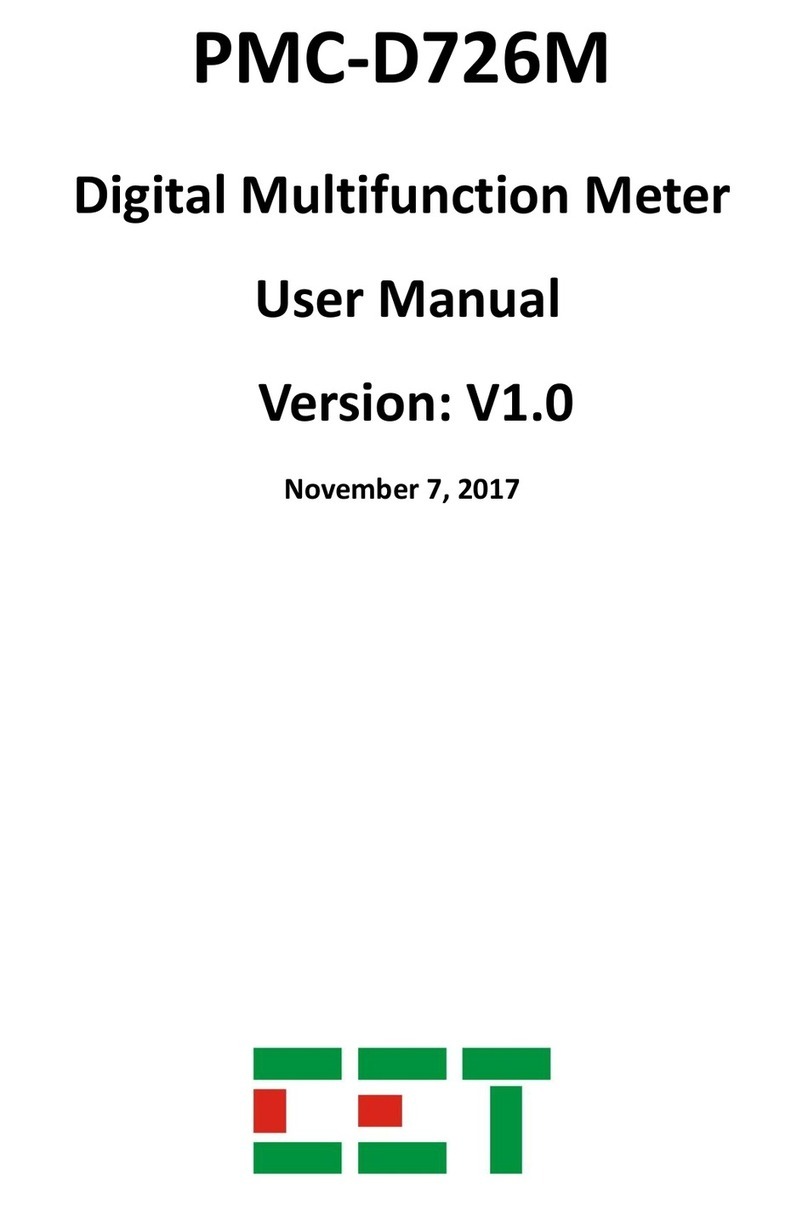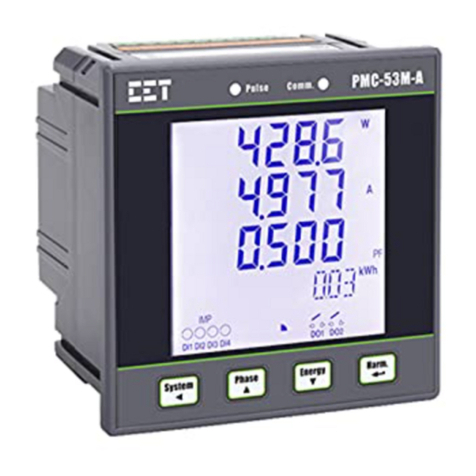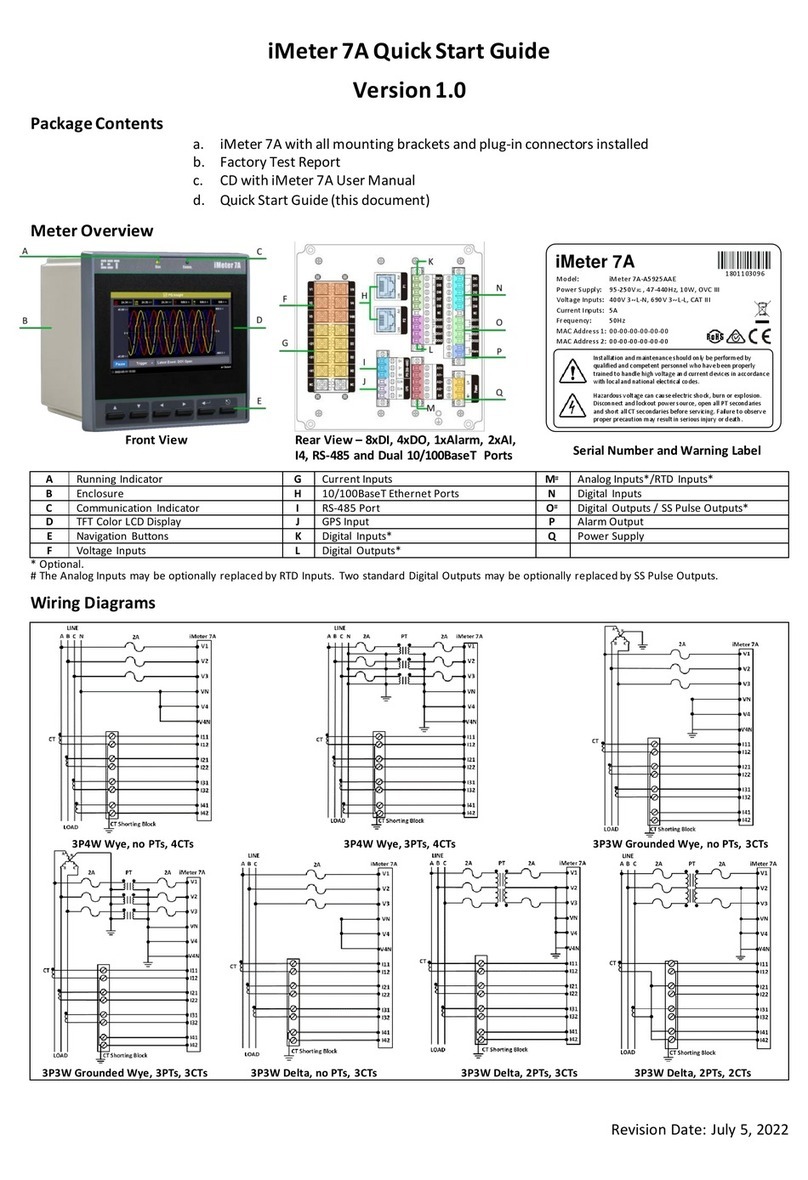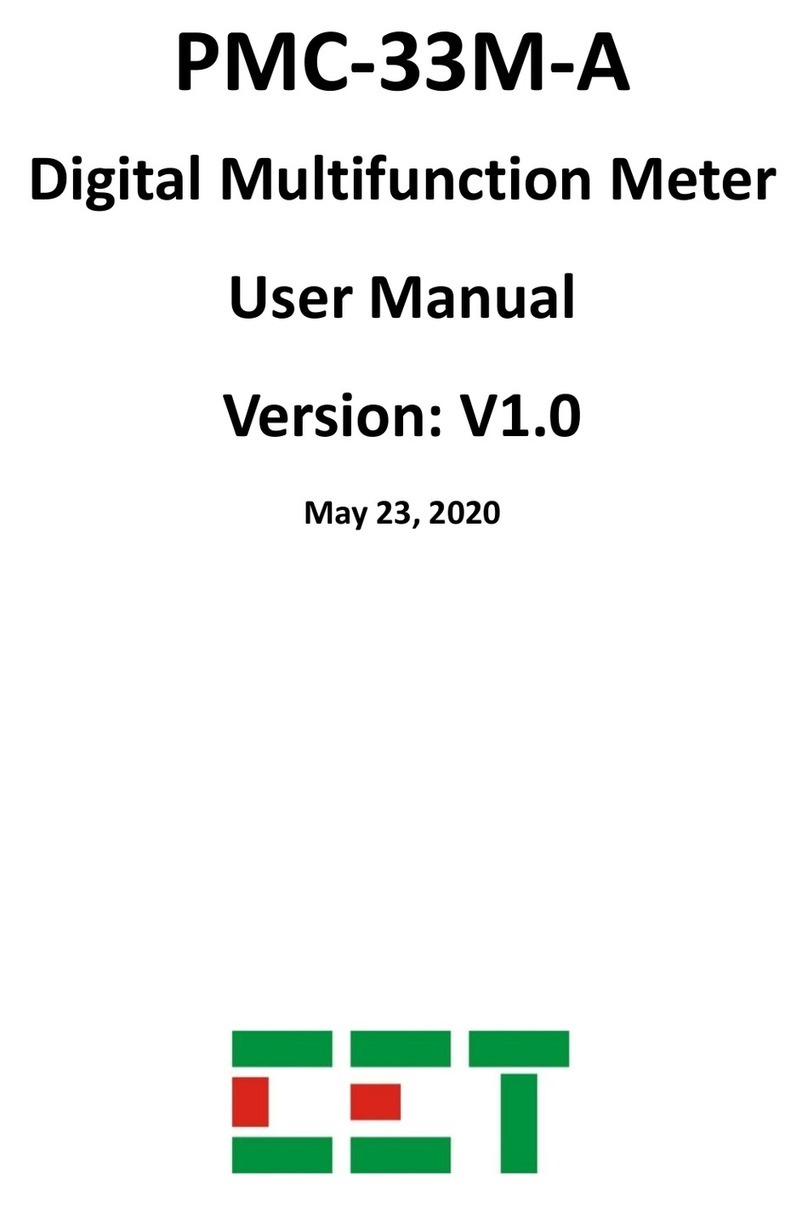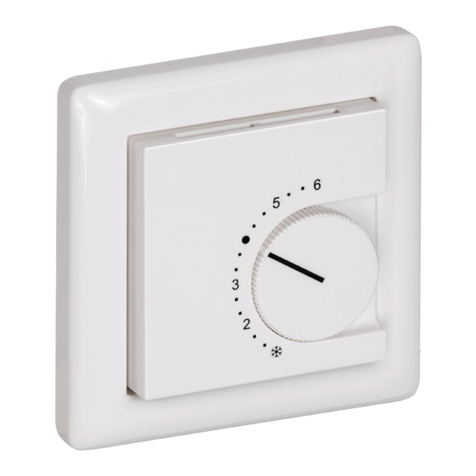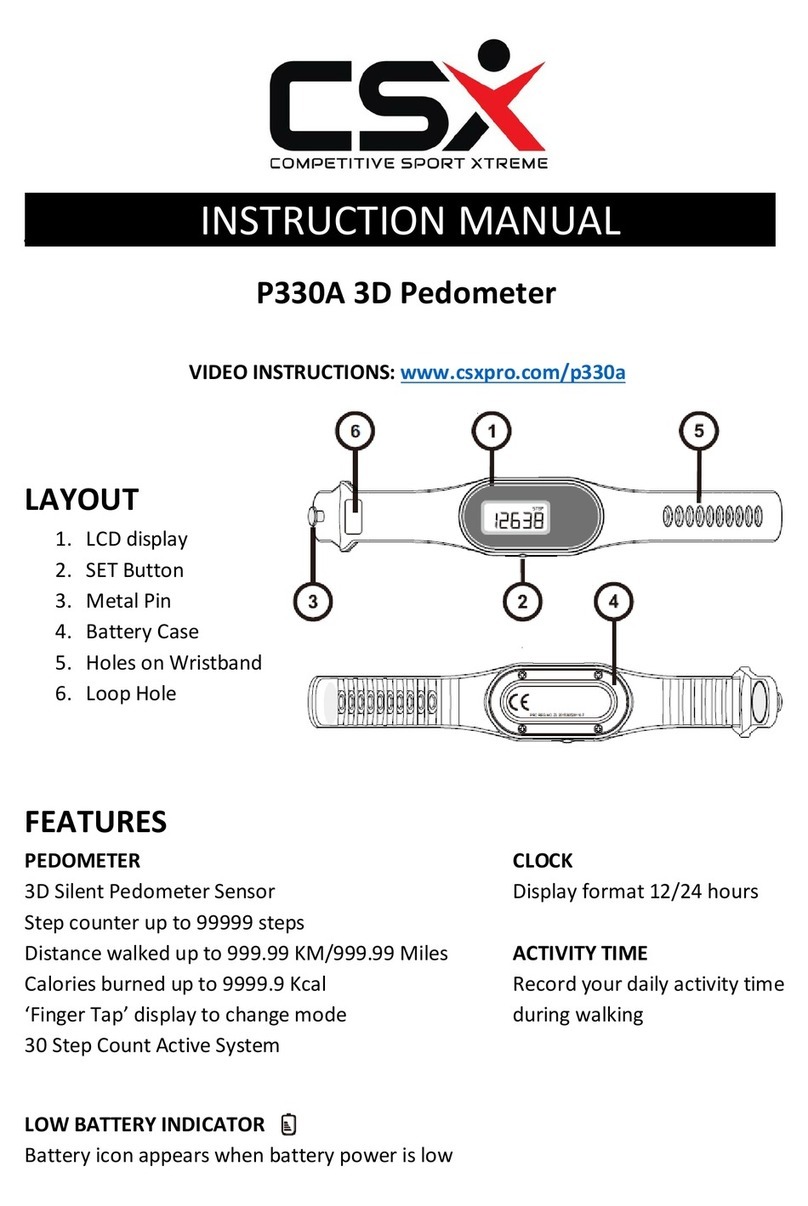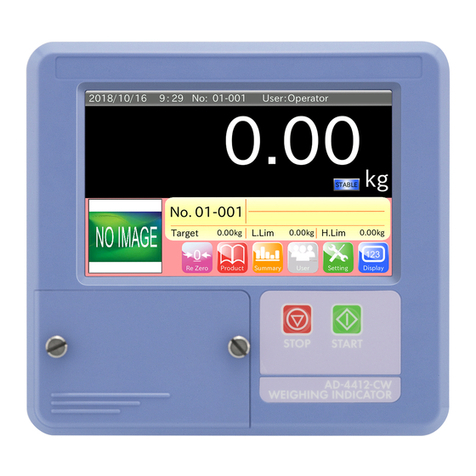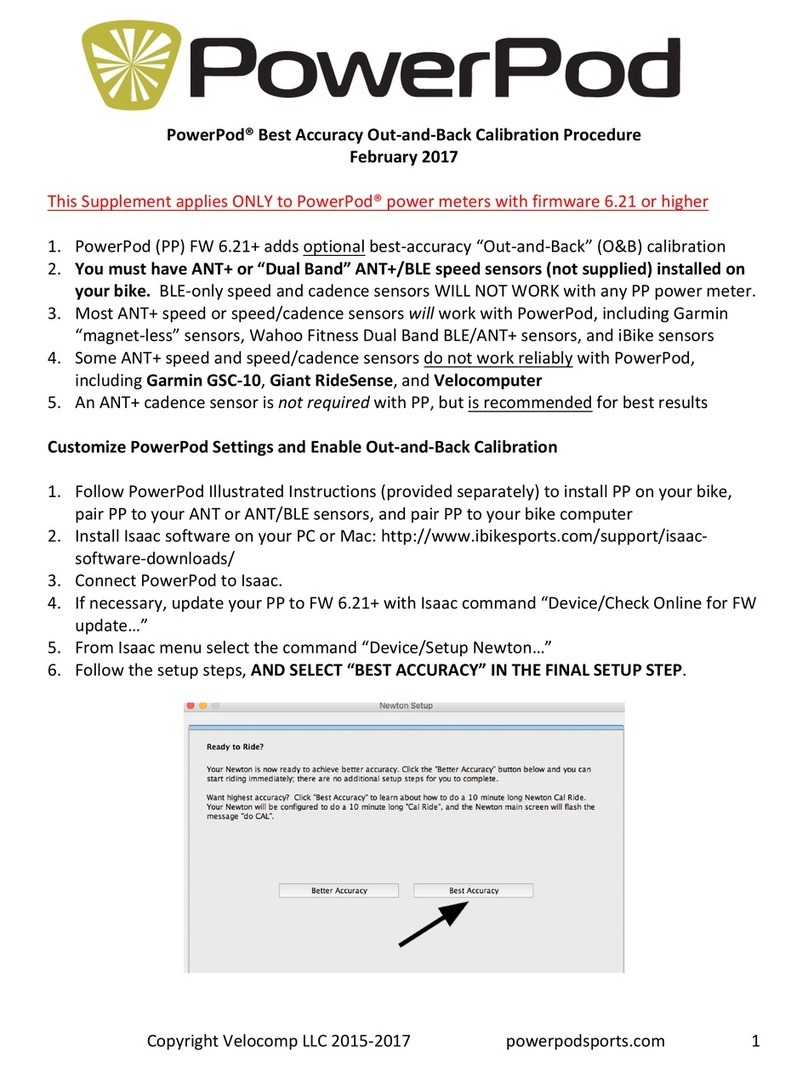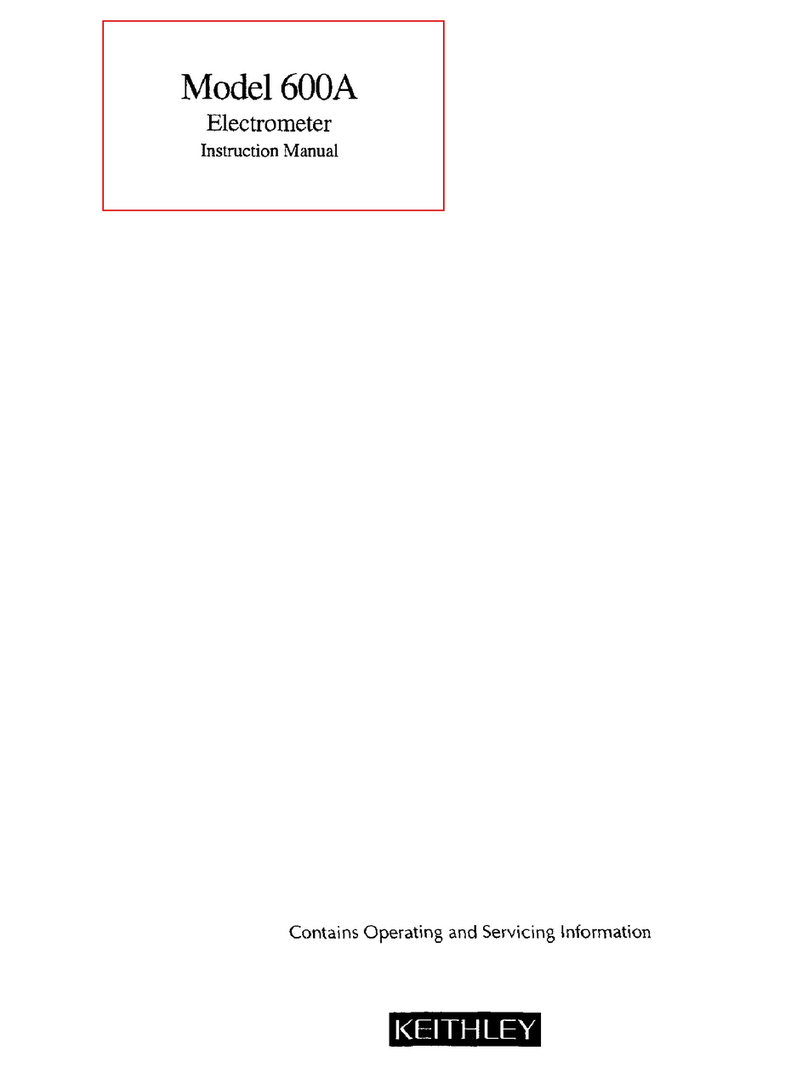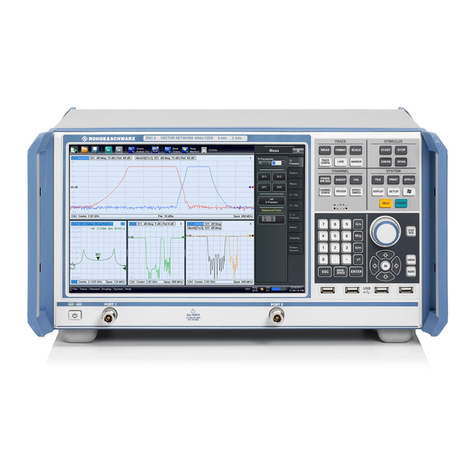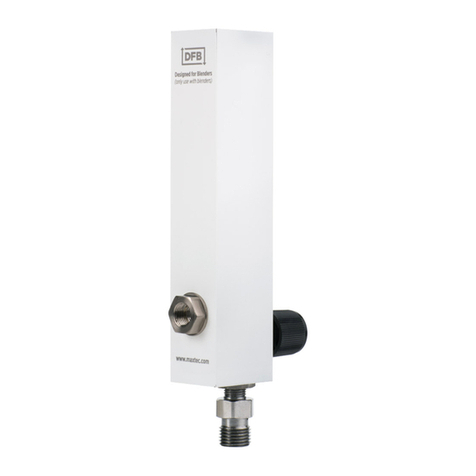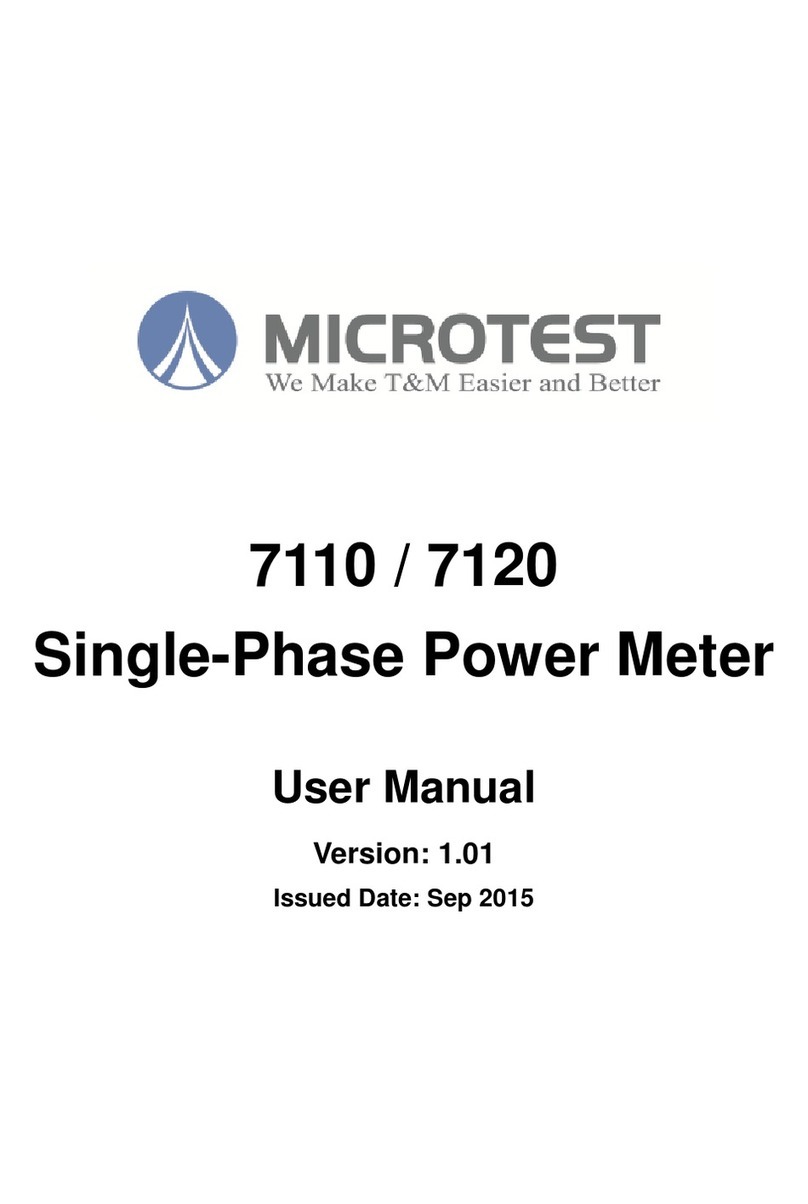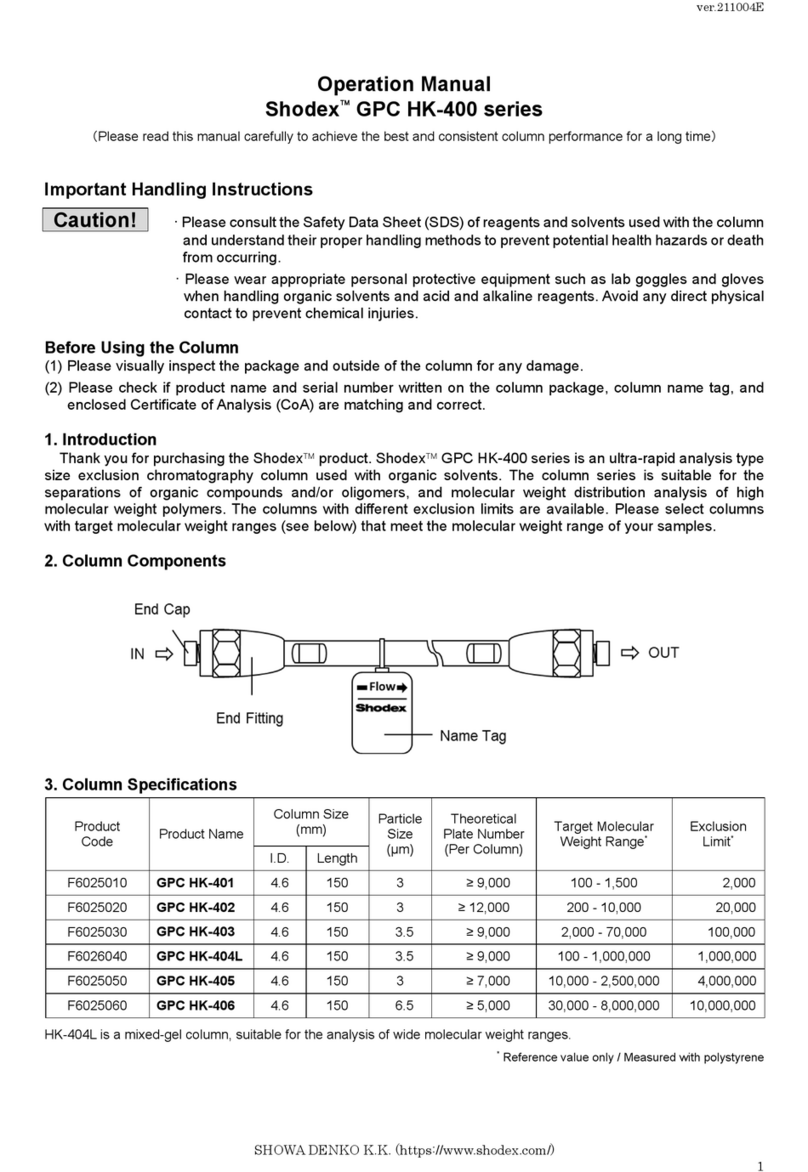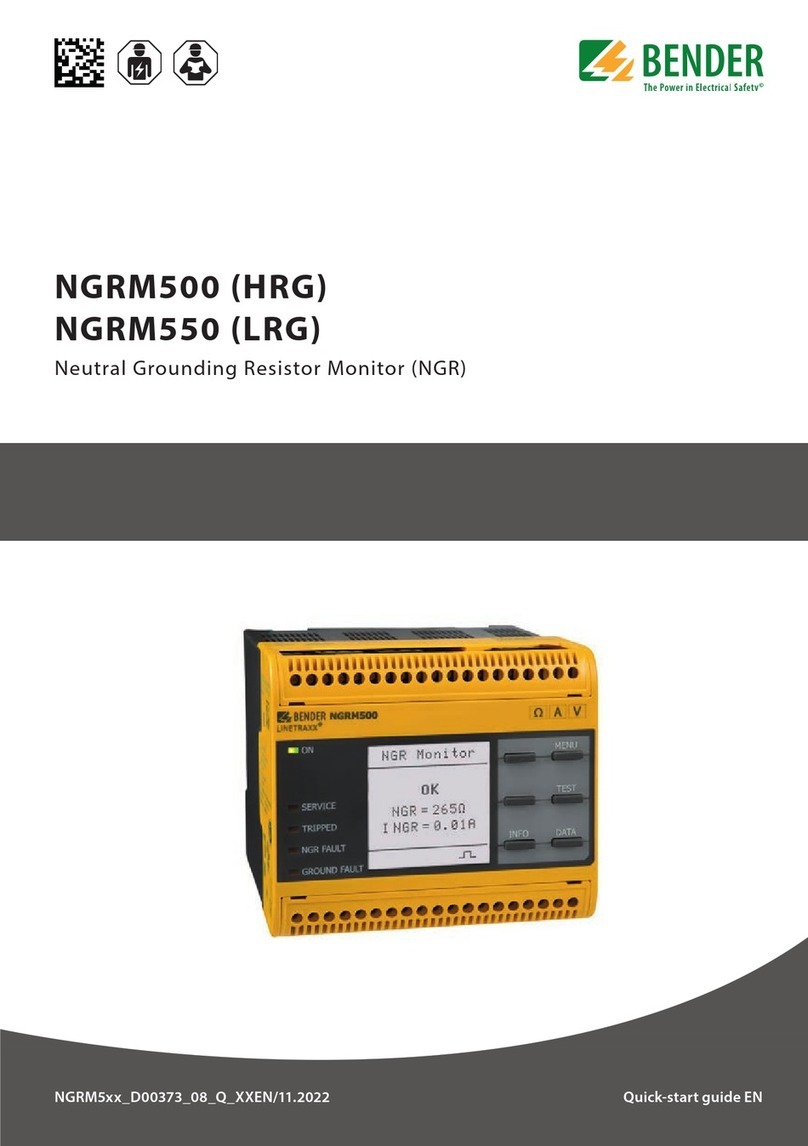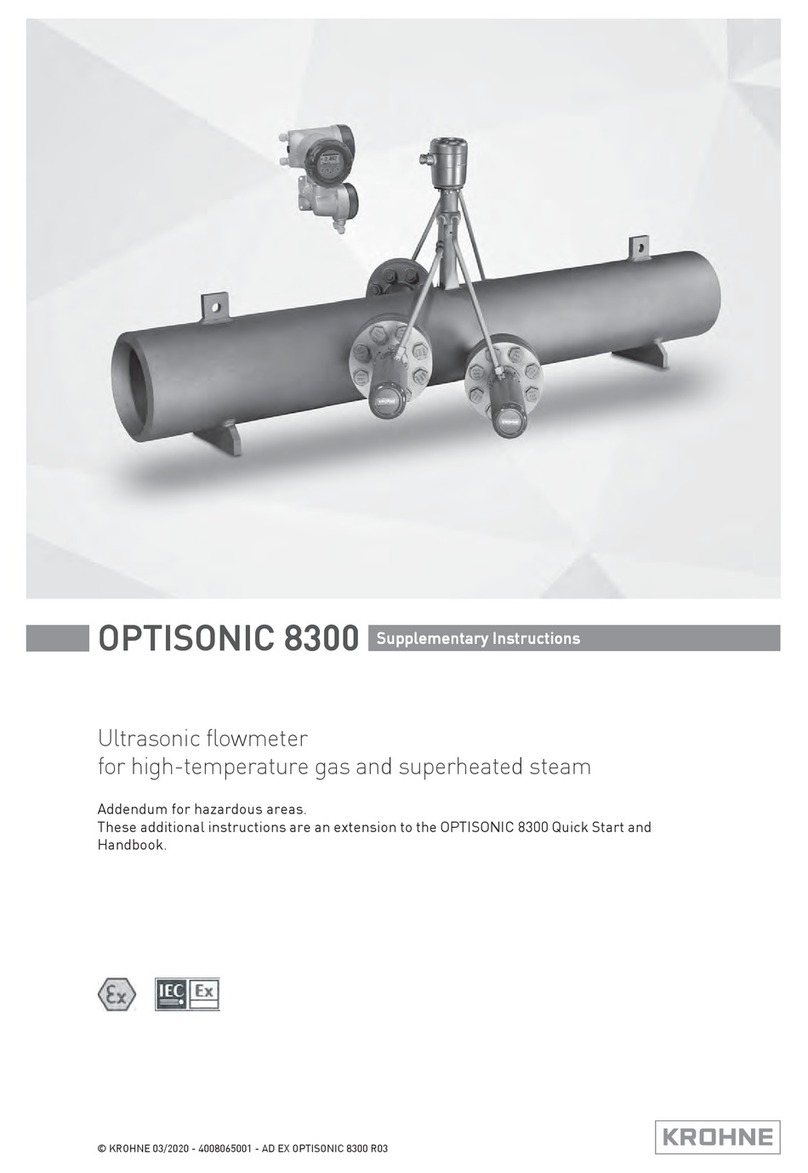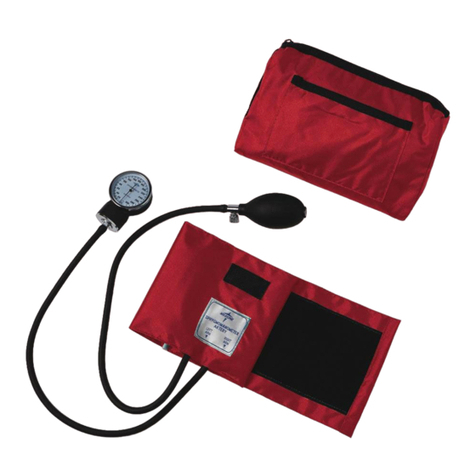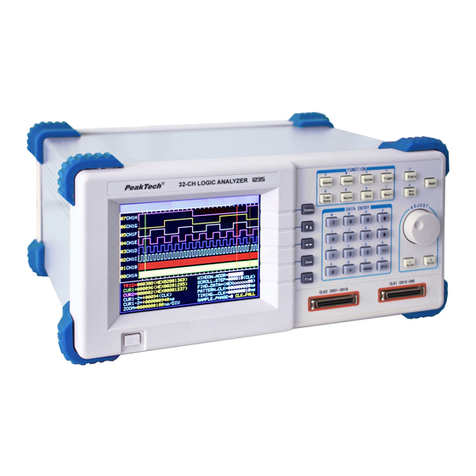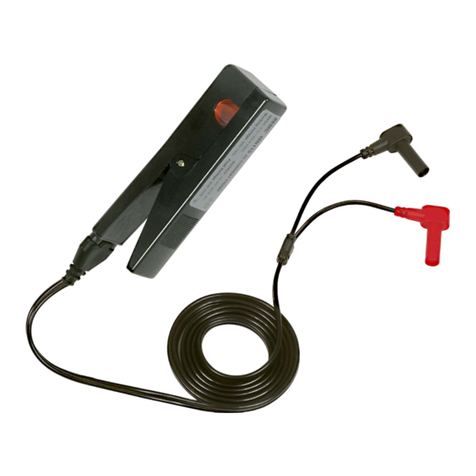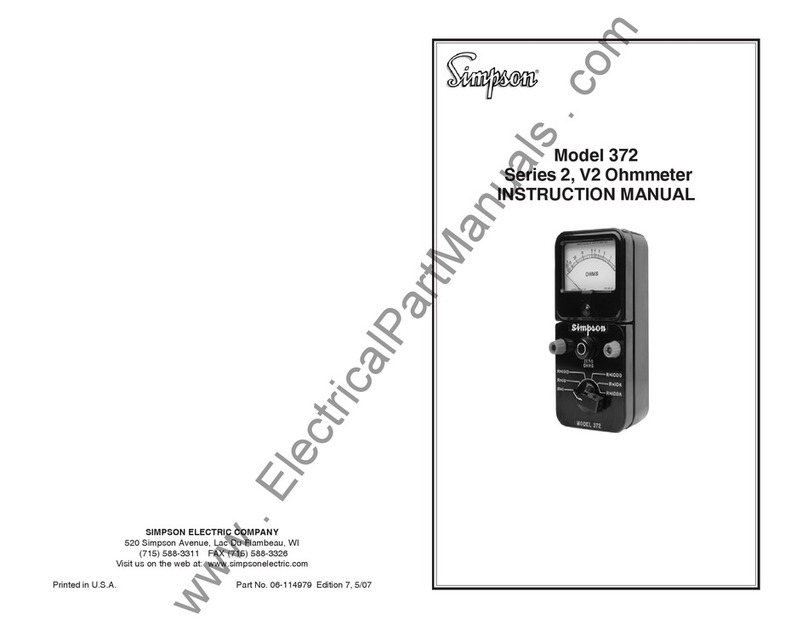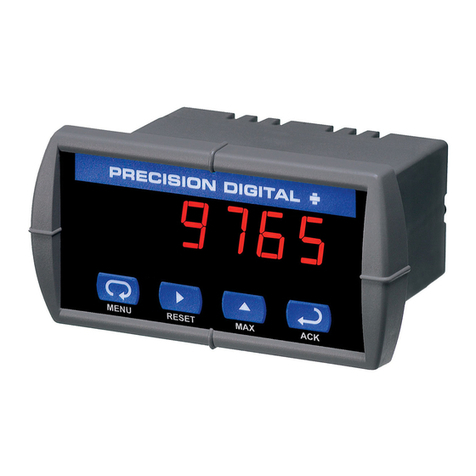EET PMC-S963-C User manual

PMC- S963-C
Intelligent Multifunction Meter
User Manual
Version: V1.0
October 8, 2023

CET Electric Technology
1
This manual may not be reproduced in whole or in part by any means without the express written
permission from CET Inc. (CET).
The information contained in this manual is believed to be accurate at the time of publication; however,
CET assumes no responsibility for any errors which may appear here and reserves the right to make
changes without notice. Please consult CET or your local representative for the latest product
specifications.
Standards Compliance
DANGER
This symbol indicates the presence of danger that may result in severe injury or death and
permanent equipment damage if proper precautions are not taken during the installation, operation
or maintenance of the device.
CAUTION
This symbol indicates the potential of personal injury or equipment damage if proper precautions are
not taken during the installation, operation or maintenance of the device.

CET Electric Technology
2
DANGER
Failure to observe the following instructions may result in severe injury or
death and/or equipment damage.
➢
Installation, operation and maintenance of the meter should only be performed
by qualified, competent personnel that have the appropriate training and
experience with high voltage and current devices. The meter must be installed in
accordance with all local and national electrical codes.
➢
Ensure that all incoming AC power and other power sources are turned OFF
before performing any work on the meter.
➢
Before connecting the meter to the power source, check the label on top of the
meter to ensure that it is equipped with the appropriate power supply, and the
correct voltage and current input specifications for your application.
➢
During normal operation of the meter, hazardous voltages are present on its
terminal strips and throughout the connected potential transformers (PT) and
current transformers (CT). PT and CT secondary circuits are capable of generating
lethal voltages and currents with their primary circuits energized. Follow standard
safety precautions while performing any installation or service work (i.e.
removing PT fuses, shorting CT secondaries, …etc).
➢
Do not use the meter for primary protection functions where failure of the device
can cause fire, injury or death. The meter should only be used for shadow
protection if needed.
➢
Under no circumstances should the meter be connected to a power source if it is
damaged.
➢
To prevent potential fire or shock hazard, do not expose the meter to rain or
moisture.
➢
Setup procedures must be performed only by qualified personnel familiar with
the instrument and its associated electrical equipment.
➢DO NOT open the instrument under any circumstances.

CET Electric Technology
3
Limited warranty
➢
CET Inc. (CET) offers the customer a minimum of 12-month functional warranty on
the meter for faulty parts or workmanship from the date of dispatch from the
distributor. This warranty is on a return to factory for repair basis.
➢
CET does not accept liability for any damage caused by meter malfunctions. CET
accepts no responsibility for the suitability of the meter to the application for which
it was purchased.
➢
Failure to install, set up or operate the meter according to the instructions herein will
void the warranty.
➢
Only CET’s duly authorized representative may open your meter. The unit should only
be opened in a fully anti-static environment. Failure to do so may damage the
electronic components and will void the warranty.

CET Electric Technology
4
Table of Contents
Table of Contents.................................................................................................................................................... 4
Chapter 1 Introduction ........................................................................................................................................... 6
1.1 Overview.......................................................................................................................................................6
1.2 Features........................................................................................................................................................6
1.3 PMC-S963-C application in Power and Energy Management Systems.........................................................8
1.4 Getting more information.............................................................................................................................8
Chapter 2 Installation ............................................................................................................................................. 9
2.1 Appearance...................................................................................................................................................9
2.2 Unit Dimensions .........................................................................................................................................10
2.3 Terminal Dimensions ..................................................................................................................................10
2.4 Mounting....................................................................................................................................................11
2.5 Wiring connections.....................................................................................................................................11
2.5.1 3-Phase 4-Wire (3P4W) Wye Direct Connection with 3CTs ..............................................................12
2.5.2 3-Phase 4-Wire (3P4W) Wye with 3PTs and 3CTs ............................................................................12
2.5.3 3-Phase 3-Wire (3P3W) Direct Delta Connection with 3CTs.............................................................13
2.5.4 3-Phase 3-Wire (3P3W) Direct Delta Connection with 2CTs.............................................................13
2.5.5 3-Phase 3-Wire (3P3W) Delta with 2PTs and 3CTs ...........................................................................14
2.5.6 3-Phase 3-Wire (3P3W) Delta with 2PTs and 2CTs ...........................................................................14
2.6 Communications Wiring .............................................................................................................................15
2.7 Digital Input Wiring.....................................................................................................................................15
2.8 Digital Output Wiring..................................................................................................................................15
2.9 Solid-State Pulse Output Wiring .................................................................................................................16
2.10 Analog Input Wiring..................................................................................................................................16
2.11 Power Supply Wiring ................................................................................................................................16
Chapter 3 Front Panel........................................................................................................................................... 17
3.1 Display ........................................................................................................................................................17
3.2 Using the Front Panel Buttons....................................................................................................................18
3.3 Data Display................................................................................................................................................19
3.3.1 Real-Time Measurement................................................................................................................19
3.3.2 Energy ...........................................................................................................................................19
3.4 Setup Configuration via the Front Panel.....................................................................................................20
3.4.1 Making Setup Changes...................................................................................................................20
3.4.2 Setup Menu...................................................................................................................................21
3.4.3 Configuration.................................................................................................................................21
Chapter 4 Applications.......................................................................................................................................... 24
4.1 Inputs and Outputs.....................................................................................................................................24
4.1.1 Digital Inputs .................................................................................................................................24
4.1.2 Digital Outputs...............................................................................................................................24
4.1.3 Energy Pulse Output ......................................................................................................................24
4.1.4 Analog Output ...............................................................................................................................24
4.2 Power and Energy.......................................................................................................................................25
4.2.1 Basic Measurements......................................................................................................................25
4.2.2 Energy Measurements ...................................................................................................................25
4.2.3 Demand Measurements.................................................................................................................25
4.3 Power Quality .............................................................................................................................................26
4.3.1 Phase Angles..................................................................................................................................26
4.3.2 Power Quality Parameters..............................................................................................................26
4.3.3 Unbalance .....................................................................................................................................27
4.3.4 Sequence Components ..................................................................................................................27
4.4 Setpoints.....................................................................................................................................................27
4.5 Logging .......................................................................................................................................................29
4.5.1 Max./Min. Log ...............................................................................................................................29
4.5.2 Max. Demand Log ..........................................................................................................................29
4.5.3 SOE Log .........................................................................................................................................29
4.5.4 12 Monthly Energy Log ..................................................................................................................30

CET Electric Technology
5
4.6 Time of Use (TOU) ......................................................................................................................................30
4.7 Diagnostics..................................................................................................................................................30
Chapter 5 Modbus Register Map.......................................................................................................................... 32
5.1 Real-Time Measurements...........................................................................................................................32
5.2 Energy Measurements................................................................................................................................33
5.2.1 3-Phase Total Energy Measurements..............................................................................................33
5.2.2 Phase A Energy Measurements ......................................................................................................34
5.2.3 Phase B Energy Measurements ......................................................................................................34
5.2.4 Phase C Energy Measurements ......................................................................................................34
5.3 Monthly Energy Log....................................................................................................................................34
5.4 Harmonic Measurements...........................................................................................................................35
5.4.1 Power Quality Measurements........................................................................................................35
5.4.2 Current Harmonic Measurements ..................................................................................................35
5.4.3 Voltage Harmonic Measurements ..................................................................................................36
5.5 Max. Demands............................................................................................................................................ 36
5.6 Max./Min. Log ............................................................................................................................................36
5.6.1 Max. Log of This Month (Since Last Reset) ......................................................................................36
5.6.2 Min. Log of This Month (Since Last Reset).......................................................................................37
5.6.3 Max. Log of Last Month (Before Last Reset)....................................................................................38
5.6.4 Min. Log of Last Month (Before Last Reset).....................................................................................38
5.6.5 Max./Min. Log Structure ................................................................................................................39
5.7 SOE Log.......................................................................................................................................................39
5.8 Device Setup...............................................................................................................................................41
5.8.1 Basic Setup Parameters..................................................................................................................41
5.8.2 I/O Setup .......................................................................................................................................42
5.8.3 Communication Setup Parameters .................................................................................................43
5.8.4 Setpoints Setup..............................................................................................................................43
5.9 TOU Setup...................................................................................................................................................44
5.9.1 Basic..............................................................................................................................................44
5.9.2 Season...........................................................................................................................................44
5.9.3 Daily Profile ...................................................................................................................................45
5.10 Time..........................................................................................................................................................45
5.11 Remote Control ........................................................................................................................................46
5.12 Clear/Reset Control ..................................................................................................................................46
5.13 Meter Information....................................................................................................................................46
Appendix A Technical Specifications..................................................................................................................... 48
Appendix B Standards Compliance....................................................................................................................... 50
Appendix C Ordering Guide .................................................................................................................................. 51
Contact us............................................................................................................................................................. 52

CET Electric Technology
6
Chapter 1 Introduction
This manual explains how to use the PMC-S963-C Intelligent Multifunction Meter. Throughout the manual the
term “meter” generally refers to all models.
This chapter provides an overview of the PMC-S963-C meter and summarizes many of its key features.
1.1 Overview
The PMC-S963-C Intelligent Multifunction Meter is CET’s latest offer for the low-cost digital power/energy
metering market. Housed in a standard DIN form factor measuring 96x96x92mm, it is perfectly suited for
industrial, commercial and utility applications. The PMC-S963-C features quality construction, multifunction
measurements and a large, backlit, 7-Segment LCD that is easy to navigate and user friendly. Compliance with
the IEC 62053-22 Class 0.5S Standard, it is a cost-effective replacement for analog instrumentation that is capable
of displaying 3-phase measurements at once. It comes standard with four Digital Inputs for status monitoring. In
addition, it optionally provides 2xDO, 1xSS Pulse Output and 1xAO for different applications. The standard RS-
485 port and Modbus RTU protocol support make the PMC-S963-C a smart metering component of an intelligent,
multifunction monitoring solution for any Energy Management System.
You can setup the meter through its front panel or via our free software. The meter is also supported by our
PecStar® iEMS Integrated Energy Management System. Following is a list of typical applications for the PMC-
S963-C:
▪Industrial, Commercial and Utility Substation Metering
▪Building, Factory and Process Automation
▪Sub-metering and Cost Allocation
▪Energy Management and Power Quality Monitoring
Contact CET Technical Support should you require further assistance with your application.
1.2 Features
Ease of use
▪Large, backlit, 7-Segment LCD display with wide viewing angle
▪Intuitive user interface
▪LED indicators for Energy Pulsing and Communication activities
▪Password protected setup via Front Panel or our free software
▪Easy installation with mounting clips, no tools required
Basic Measurements
▪True RMS @ 64 Samples/Cycle
▪ULN, ULL per Phase and Average
▪Current per Phase and Average with calculated Neutral
▪P, Q, S, PF per Phase and Total
▪Total RMS kWh, kvarh Import/Export/Net/Total and kVAh Total
▪Per-phase kWh, kvarh Import/Export
▪Frequency
Advanced Measurements
▪U and I THD, TOHD, TEHD, TH (RMS) and Individual Harmonics up to 31st
▪Current TDD, TDD Odd, TDD Even and Crest Factor
▪U and I Sequence, Unbalance and Phase Angle
▪Fundamental U and I per Phase
▪kvarh Q1-Q4
▪P Present and Predicted Demands as well as Max. Demands with Timestamp for This Month & Last Month
(or Since Last Reset & Before Last Reset)
▪One TOU schedule providing
o4 Seasons
o4 Daily Profiles, each with 14 Periods in 15-minute interval
o4 Tariffs, each providing kWh Import
▪12 monthly recording of kWh/kvarh Import/Export/Total/Net, kVAh Total, kvarh Q1-Q4 as well as kWh
Import per Tariff

CET Electric Technology
7
Setpoints
▪9 user programmable setpoints with extensive list of monitoring parameters including Voltage, Current,
Power, P Demand, Unbalance, Phase Reversal and THD, etc.
▪Configurable thresholds, time delays and DO triggers
SOE Log
▪32 events time-stamped to ±1ms resolution
▪Setup changes, Setpoint and DI status changes and DO operations
Max./Min. Log
▪Max./Min. Log with Timestamp for Real-time measurements such as Voltage, Current, In (Calculated), Freq.,
P, Q, S, PF, Unbalance and THD
▪Configurable for This Month & Last Month (or Since Last Reset & Before Last Reset)
Diagnostics
▪Loss of Voltage / Current
▪P Direction per Phase and Total
▪Incorrect U & I Phase Sequence
Inputs and Outputs
▪Digital Inputs
o4 channels, volt free dry contact, 24VDC internally wetted
o1000Hz sampling for status monitoring with programmable debounce
▪Digital Outputs
o2 Form A Mechanical Relays for alarming and general purpose control
▪Pulse Output
o1 Form A Solid-State Relay for kWh and kvarh pulsing
▪Analog Output (Optional)
oOne channel 0/4-20mA DC output with programmable zero and full scales
Communications
▪Optically isolated RS-485 port at max. 38,400 bps
▪Standard Modbus RTU Support
Real-Time Clock
▪Equipped with a battery-backed Real-Time Clock with 25ppm accuracy (<2s per day)
System Integration
▪Supported by CET’s PecStar® iEMS
▪Easy integration into 3rd-party Energy Management, Automation, SCADA or BMS systems via Modbus RTU

CET Electric Technology
8
1.3 PMC-S963-C application in Power and Energy Management Systems
The PMC-S963-C can be used to monitor Wye or Delta connected power system. Modbus communications allow
real-time data, DI status and other information to be transmitted across a RS-485 network to an Integrated
Energy Management system such as PecStar® iEMS.
1.4 Getting more information
Additional information is available from CET via the following sources:
▪Visit www.cet-global.com
▪Contact your local representative
▪Contact CET directly via email at support@cet-global.com

CET Electric Technology
9
Chapter 2 Installation
2.1 Appearance
Figure 2-1 Appearance
Caution
Installation of the PMC-S963-C should only be performed by qualified and competent
personnel who have the appropriate training and experience with high voltage and current
devices. The meter must be installed in accordance with all local and national electrical codes.
During the operation of the meter, hazardous voltages are present at the input terminals.
Failure to observe precautions can result in serious or even fatal injury and equipment
damage.

CET Electric Technology
10
2.2 Unit Dimensions
Figure 2-2 Unit Dimensions
2.3 Terminal Dimensions
Figure 2-3 Terminal Dimensions
No.
Terminal
Terminal Dimensions
Wire Size
Max. Torque
1
RS-485
2.6mm x 3.2mm
1.5mm2
5 kgf.cm/M3
(5 lb-in)
Digital Input
Solid-State Pulse Output
Digital Output
Power Supply
2
Voltage Input
5.8mm x 5.8mm
1.0 mm2 -2.5 mm2
14-22AWG
8.0 kgf.cm/M3
(6.9lb-in)
Current Input
Table 2-1 Terminal Dimensions
Unit: mm

CET Electric Technology
11
2.4 Mounting
The PMC-S963-C should be installed in a dry and dust-free environment and kept away from heat, radiation and
electrical noise sources.
Installation steps:
▪Remove the installation clips from the meter
▪Fit the meter through a 96mmx96mm cutout as shown in Figure 2-4
▪Re-install the installation clips and push the clips tightly against the panel to secure the meter
Figure 2-4 Panel Cutout Mounting
2.5 Wiring connections
PMC-S963-C can satisfy almost any three phase power systems. Please read this section carefully before
installation and choose the correct wiring method for your power system. The following Wiring Modes are
supported:
▪3-Phase 4-Wire (3P4W) Wye Direct Connection with 3CTs
▪3-Phase 4-Wire (3P4W) Wye with 3PTs and 3CTs
▪3-Phase 3-Wire (3P3W) Direct Delta Connection With 3CTs
▪3-Phase 3-Wire (3P3W) Direct Delta Connection with 2CTs
▪3-Phase 3-Wire (3P3W) Delta with 2PTs and 3CTs
▪3-Phase 3-Wire (3P3W) Delta with 2PTs and 2CTs
Caution
Under no circumstances should the PT secondary be shorted.
Under no circumstances should the CT secondary be open when the CT primary is
energized. CT shorting blocks should be installed to allow for easy maintenance.

CET Electric Technology
12
2.5.1 3-Phase 4-Wire (3P4W) Wye Direct Connection with 3CTs
Please consult the serial number label to ensure that the rated system phase voltage is less than or equal to the
meter’s rated phase voltage input specification. Set the Wiring Mode to 3P4W.
Figure 2-5 3P4W Direct Connection with 3CTs
2.5.2 3-Phase 4-Wire (3P4W) Wye with 3PTs and 3CTs
Please consult the serial number label to ensure that the rated PT secondary voltage is less than or equal to the
meter’s rated phase voltage input specification. Set the Wiring Mode to 3P4W.
Figure 2-6 3P4W with 3PTs and 3CTs

CET Electric Technology
13
2.5.3 3-Phase 3-Wire (3P3W) Direct Delta Connection with 3CTs
Please consult the serial number label to ensure that the rated system line voltage is less than or equal to the
meter’s rated line voltage input specification. Set the Wiring Mode to 3P3W.
Figure 2-7 3P3W Direct Connection with 3CTs
2.5.4 3-Phase 3-Wire (3P3W) Direct Delta Connection with 2CTs
Please consult the serial number label to ensure that the rated system line voltage is less than or equal to the
meter’s rated line voltage input specification. Set the Wiring Mode to 3P3W.
Figure 2-8 3P3W Direct Connection with 2CTs

CET Electric Technology
14
2.5.5 3-Phase 3-Wire (3P3W) Delta with 2PTs and 3CTs
Please consult the serial number label to ensure that the rated PT secondary voltage is less than or equal to the
meter’s rated phase voltage input specification. Set the Wiring Mode to 3P3W.
Figure 2-9 3P3W Delta with 2PTs and 3CTs
2.5.6 3-Phase 3-Wire (3P3W) Delta with 2PTs and 2CTs
Please consult the Serial Number Label to ensure that the rated PT secondary voltage is less than or equal to the
meter’s rated phase voltage input specification. Set the Wiring Mode to 3P3W.
Figure 2-10 3P3W Delta with 2PTs and 2CTs

CET Electric Technology
15
2.6 Communications Wiring
The PMC-S963-C provides one standard RS-485 port which supports the Modbus RTU protocol. Up to 32 devices
can be connected on a RS-485 bus. The overall length of the RS-485 cable connecting all devices should not
exceed 1200m.
If the master station does not have a RS-485 communications port, a RS-232/RS-485 or USB/RS-485 converter
with optically isolated output and surge protection should be used.
The following figure illustrates the RS-485 communications connections on the PMC-S963-C:
Figure 2-11 Communications Connections
2.7 Digital Input Wiring
The following figure illustrates the Digital Input connections on the PMC-S963-C:
Figure 2-12 DI Connections
2.8 Digital Output Wiring
The following figure illustrates the Digital Output connections on the PMC-S963-C:
Figure 2-13 DO Connections
The following figure illustrates the Digital Output connections when the DO is used for controlling circuit breaker.
Figure 2-14 DO Connections for Controlling Circuit Breaker

CET Electric Technology
16
2.9 Solid-State Pulse Output Wiring
The following figure illustrates the Solid-State Pulse Output connections on the PMC-S963-C:
Figure 2-15 Solid-State Pulse Output Connections
2.10 Analog Input Wiring
The following figure illustrates the Analog Input connections on the PMC-S963-C:
Figure 2-16 AI Connections
2.11 Power Supply Wiring
For AC supply, connect the live wire to the L/+ terminal and the neutral wire to the N/- terminal.
For DC supply, connect the positive wire to the L/+ terminal and the negative wire to the N/- terminal.
Figure 2-17 Power Supply Connections

CET Electric Technology
17
Chapter 3 Front Panel
The PMC-S963-C has a large, easy to read LCD display with backlight and four buttons for data display and meter
configuration. This chapter introduces the front panel operations.
Figure 3-1 Front Panel
3.1 Display
This section provides a description of the LCD display areas which can generally be divided into 5 areas:
Figure 3-2 LCD Display
The following table shows the special LCD display symbols:
Area
Label
Description
A
A
B
C
D
E
F
G
H
I
J
K
L
M
N
O
P
Q
R
S
T
U
V
W
Y
0
1
2
3
4

CET Electric Technology
18
B
PF Quadrant-
Q1/Q2/Q3/Q4
C1: RS-485 Communication status
C2: Reserved
Phase AB/BC/CA/A/B/C
This Month
Last Month
Maximum
Minimum
Average
Negative Symbol
Phase Angle Symbol
THD
Demand
Unbalance
C
Measurement Units for Frequency, Power (P, Q, S) and THD
PF
Net, Total
Reserved
D
Measurement Units for kWh, kvarh and kVAh
E
DI Closed
DI Open
DO Released
DO Operated
Tariff 1- 4
Reserved
Table 3-1 Special LCD display symbols
3.2 Using the Front Panel Buttons
The PMC-S963-C’s front panel has been designed with a 4-button user-friendly interface that allows users to
quickly scroll through most of the available measurements. The default password is 0 (one zero).
Buttons
Data Display Mode
Setup Configuration Mode
<Energy/ >
Pressing this button toggles
between Real-time Measurements*
and Energy Measurements.
•Once a numeric parameter is selected, pressing
this button moves the cursor to the left by one
position. Otherwise, this button is ignored.
< >
Pressing this button advances to the
next measurement page.
•Before a parameter is selected for modification,
pressing this button advances to the next
parameter or menu.
•If a parameter is already selected, pressing this
button decrements a numeric value or advances
to the next enumerated value in the selection list.
< >
Pressing this button returns to the
previous measurement page.
•Before a parameter is selected for modification,
pressing this button returns to previous
parameter or menu.
•If a parameter is already selected for
modification, pressing this button increments a
numeric value or goes back to the last
enumerated value in the selection list.
<Setup/ >
Pressing this button returns to the
•Once inside the Setup Configuration mode,

CET Electric Technology
19
default page (P/Q/S Total).
Pressing this button for more than 2
seconds enters the Setup
Configuration mode.
pressing this button selects a parameter for
modification or chooses whether to enter a sub-
menu.
•After changing the parameter, pressing this
button again saves the new setting into memory.
•Pressing this button for more than 2 seconds
returns to previous menu or exits Setup
Configuration mode.
<Energy/ >
&
<Setup/ >
Pressing this combination for 2 seconds enters or exits the Quick Setup mode which
provides quickly configuration for parameters CT1, CT2, PT1, PT2 and ID (Unit ID).
* The Real-time Measurements include P/Q/S per Phase and Total, ULN/ULL/I/PF per Phase and Average, In (Calculated ) as well as Freq., P Present and Predicted
Demands as well as This/Last Max. Demand, U & I Phase Angle, Unbalances, THD/TOHD/TEHD per Phase and Individual Harmonics from 2nd to 31st.
Table 3-2 Button Function
3.3 Data Display
The following sections illustrate the available measurements for each display option. Depending on the Wiring
Mode selected, certain measurements may not be available. For example, the per-phase ULN, ULN Average, per-
phase P, Q, S and PF measurements are not available when the Wiring Mode is set to 3P3W.
3.3.1 Real-Time Measurement
Display Screens
1st Row
2nd Row
3rd Row
4th Row
Display 1
P Total
Q Total
S Total
kWh
Display 21
Uan
Ubn
Ucn
kWh
Display 3
Uab
Ubc
Uca
kWh
Display 4
Ia
Ib
Ic
kWh
Display 5
-
-
In
kWh
Display 6
Pa
Pb
Pc
kWh
Display 7
Qa
Qb
Qc
kWh
Display 8
Sa
Sb
Sc
kWh
Display 9
PFa
PFb
PFc
kWh
Display 10
-
PF Total
-
kWh
Display 11
-
-
Frequency
kWh
Display 12
P Present Dmd.
kWh
Display 13
P Predicted Dmd.
kWh
Display 14
P Max. Demand of This Month (Since Last Reset)
Display 15
P Max. Demand of Last Month (Before Last Reset)
Display 16
Uan Phase Angle
Ubn Phase Angle
Ucn Phase Angle
kWh
Display 17
Uab Phase Angle
Ubc Phase Angle
Uca Phase Angle
kWh
Display 18
Ia Phase Angle
Ib Phase Angle
Ic Phase Angle
kWh
Display 19
U Unbalance
Display 20
I Unbalance
Display 21
Uan THD
Ubn THD
Ucn THD
Display 22
Uan TOHD
Ubn TOHD
Ucn TOHD
Display 23
Uan TEHD
Ubn TEHD
Ucn TEHD
Display 24
Ia THD
Ib THD
Ic THD
Display 25
Ia TOHD
Ib TOHD
Ic TOHD
Display 26
Ia TEHD
Ib TEHD
Ic TEHD
Display 27
Uan/Uab HD02
Ubn/Ubc HD02
Ucn/Uca HD02
Display 28
Uan/Uab HD03
Ubn/Ubc HD03
Ucn/Uca HD03
…
…
…
…
Display 56
Uan/Uab HD31
Ubn/Ubc HD31
Ucn/Uca HD31
Display 57
Ia HD02
Ib HD02
Ic HD02
Display 58
Ia HD03
Ib HD03
Ic HD03
…
…
…
…
Display 86
Ia HD31
Ib HD31
Ic HD31
Table 3-3 Default Display
Notes:
1) This screen is not shown if the Wiring Mode is set to 3P3W.
3.3.2 Energy
Display Screens
1st Row
2nd Row
3rd Row
4th Row
Display 1
kWh Import
Display 2
kWh Export
Table of contents
Other EET Measuring Instrument manuals
